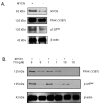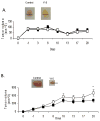Inhibition of focal adhesion kinase decreases tumor growth in human neuroblastoma
- PMID: 20160475
- PMCID: PMC2855768
- DOI: 10.4161/cc.9.5.10936
Inhibition of focal adhesion kinase decreases tumor growth in human neuroblastoma
Abstract
Neuroblastoma is the most common extracranial solid tumor of childhood. Focal adhesion kinase (FAK) is an intracellular kinase that regulates both cellular adhesion and apoptosis. FAK is overexpressed in a number of human tumors including neuroblastoma. Previously, we have shown that the MYCN oncogene, the primary adverse prognostic indicator in neuroblastoma, regulates the expression of FAK in neuroblastoma. In this study, we have examined the effects of FAK inhibition upon neuroblastoma using a small molecule [1,2,4,5-benzenetetraamine tetrahydrochloride (Y15)] to inhibit FAK expression and the phosphorylation of FAK at the Y397 site. Utilizing both non-isogenic and isogenic MYCN(+)/MYCN(-) neuroblastoma cell lines, we found that Y15 effectively diminished phosphorylation of the Y397 site of FAK. Treatment with Y15 resulted in increased detachment, decreased cell viability and increased apoptosis in the neuroblastoma cell lines. We also found that the cell lines with higher MYCN are more sensitive to Y15 treatment than their MYCN negative counterparts. In addition, we have shown that treatment with Y15 in vivo leads to less tumor growth in nude mouse xenograft models, again with the greatest effects seen in MYCN(+) tumor xenografts. The results of the current study suggest that FAK and phosphorylation at the Y397 site plays a role in neuroblastoma cell survival, and that the FAK Y397 phosphorylation site is a potential therapeutic target for this childhood tumor.
Figures






Comment in
-
Targeting the MYCN effector, FAK, in neuroblastoma.Cell Cycle. 2010 Mar 15;9(6):1026. Epub 2010 Mar 15. Cell Cycle. 2010. PMID: 20410685 No abstract available.
-
Unraveling the relationship between n-myc and Focal Adhesion Kinase (FAK) in neuroblastoma?Cell Cycle. 2010 May;9(9):1679-80. Epub 2010 May 1. Cell Cycle. 2010. PMID: 20448460 No abstract available.
References
-
- Maris JM, Matthay KK. Molecular biology of neuroblastoma. J Clin Oncol. 1999;17(7):2263–79. - PubMed
-
- Cotterill SJ, Parker L, More L, Craft AW. Neuroblastoma: changing incidence and survival in young people aged 0–24 years. A report from the North of England Young Persons’ Malignant Disease Registry. Med Pediatr Oncol. 2001;36(1):231–4. - PubMed
-
- Brodeur GM, Seeger RC, Schwab M, Varmus HE, Bishop JM. Amplification of N-myc in untreated human neuroblastomas correlates with advanced stage disease. Science. 1984;224(4653):1121–4. - PubMed
-
- Seeger RC, Brodeur GM, Sather H, Dalton A, Siegle SE, Wong KY, et al. Association of multiple copies of the N-myc oncogene with rapid progression of neuroblastomas. N Engl J Med. 1985;313(18):1111–6. - PubMed
-
- Zaizen Y, Taniguchi S, Noguchi S, Suita S. The effect of N-myc amplification and expression on invasiveness of neuroblastoma cells. J Pediatr Surg. 1993;28(6):766–9. - PubMed
Publication types
MeSH terms
Substances
Grants and funding
LinkOut - more resources
Full Text Sources
Medical
Molecular Biology Databases
Miscellaneous
